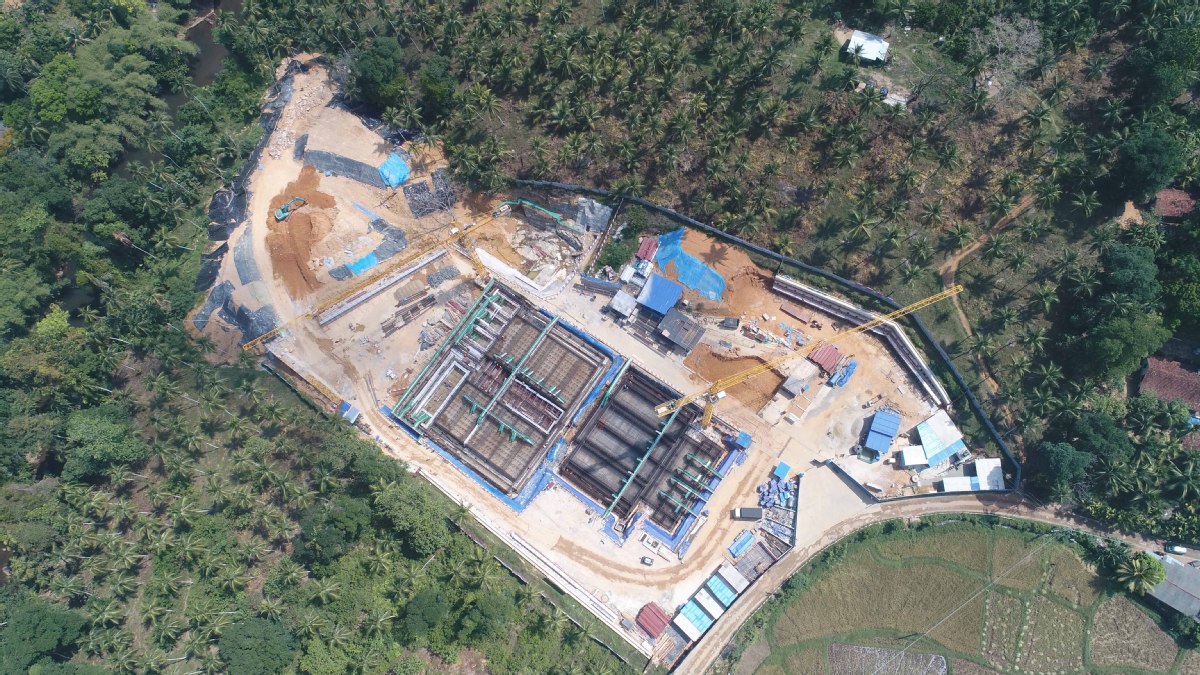
An aerial photograph shows the site of Gampaha, Attanagalla and Minuwangoda integrated water supply project in February. ( Photo: KELUM SHIVANTHA/FOR CHINA DAILY)
China Development Bank provided 85 percent of funds in Sri Lanka
Deep in the hilly woods of Sri Lanka, a water plant project is under construction by Chinese and local workers. By early next year, it aims to bring clean and safe water to 600,000 nearby residents.
The China Machinery Engineering Corporation, or CMEC, is the largest company involved in building the pipe-borne water treatment plant 40 kilometers north of the capital city of Colombo in the western part of the country.
According to Yang Wei, executive manager at the site of Gampaha, Attanagalla and Minuwangoda integrated water supply plant, or GAMIWSS, it is one of the biggest China-Sri Lanka cooperation projects and aims to elevate the local people's livelihood.
About 200 workers are presently working with steel and cement at the site. The peak phase of the project engaged 300 workers, including 200 or so local staff.
The island nation of Sri Lanka has abundant freshwater. Over two-thirds of the nation receives an annual rainfall of more than 1,500 mm and most areas are usually green. Yet, it is essential to clean existing water resources for public use.
According to the World Health Organization, acidity and heavy metal residue in drinking water is one of the main causes for chronic kidney disease of unidentified etiology, or CKDu, one of the most serious non-communicable diseases affecting thousands of people in Sri Lanka and a major burden on the country's health system.
Dr Kamal Gammanpila, a researcher at Imperial College University in London, said high use of chemical fertilizers also contributes to CKDu.
Data from the National Water Supply and Drainage Board show 35 percent of households in the nation of more than 20 million people are in dire need of clean, pipe-borne fresh water.
Yang said the water treatment plant will have a daily processing capacity of 54,000 tons and a daily water supply of 85,000 tons. It includes a comprehensive infrastructure for the supply and laying of 720 kilometers of pipe network apart from the plant itself.
The builders have "to cut paths through mountains and build bridges across rivers", Yang was quoted by a report on cmec.com website.
"If there is no road, we build one. If there are low-lying areas, we fill them up. If the hillside goes beyond the elevation, we move it away. If the construction space is small, we increase the comprehensive utilization. Methods are always more than difficulties!" Yang said.
So far, 70 percent of the construction has been completed and upon completion, he said. "After this is complete, it will cover water supply for 197 square kilometers."
The Attanagalla water project, initiated in 2014, uses the water source of a branch of the Attanagalu Oya to divert water from Karasnagala. Its main objective is to solve the water needs in the Attanagalla, Mirigama, Minuwangoda and Mahara areas of Gampaha District in the Western Province.
The project is 85 percent funded by the China Development Bank. The Bank of Ceylon will provide the government with the rest 15 percent. The total estimated cost of the project is $34 million.
At the construction site a bodhi tree is often seen draped in protective "armor" despite limited space. Yang said their staffs specially provide a piece of land for this tree because they've learned that local people see the bodhi tree as sacred because Buddha found enlightenment under a bodhi tree.
Yang said usually one tower crane is sufficient for such a limited site. However, due to the special geographical location of the project, a tower crane cannot cover the whole construction area with affecting the surrounding trees. "We have no choice but to provide another tower crane in the diagonal position," he said.
As one of the earliest Chinese companies operating in Sri Lanka, CMEC is keen on local public welfare while undertaking important construction projects. Whenever there is a natural disaster in Sri Lanka, CMEC is always the first foreign company to donate relief supplies to the affected people, Yang said.
At the end of last year, CMEC donated a batch of water purification equipment to Mihintale Temple and the people of surrounding areas in the North-Central part of Sri Lanka. "This measure was highly appreciated," Yang said.
He also suggested that Sri Lanka build more purifiers and a proper sewage system to ensure clean water.
Noting that many Sri Lankans use shallow wells to draw drinking water, Yang said that the country has many suitable locations where water purifiers could be built for a healthier, and a more concrete solution.


